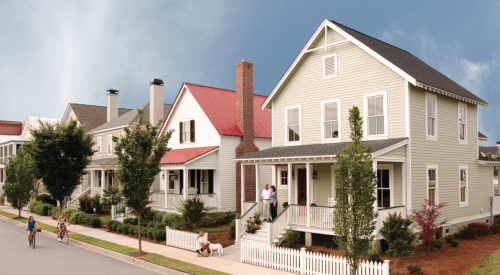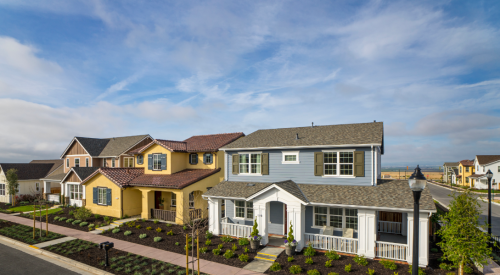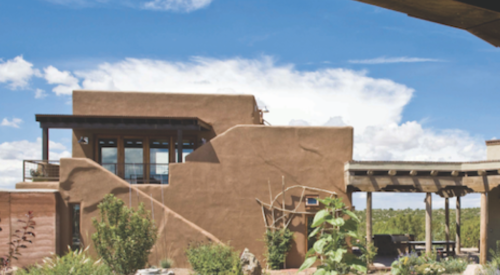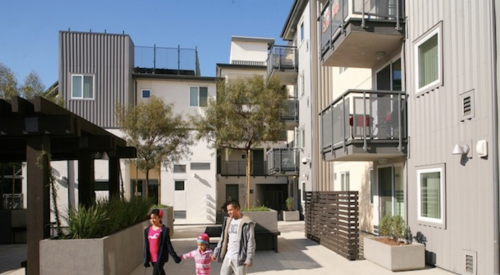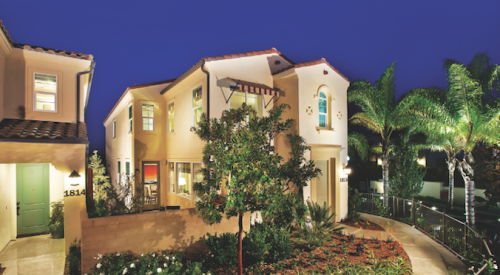Creating a new master-planned community in and around an existing "town" requires sensitivity. It means preserving the historical character while creating a modern community with residential, retail and commercial space. An existing historical setting provides the hometown feeling that draws buyers.
When done correctly, as it was at a former U.S. Air Force base in Novato, Calif., the rewards are great. Sales rates at Hamilton are soaring like airplanes used to do at Hamilton Field. Buyers snap up houses from four initial builders as soon as a new phase is released.
| Four builders present one message. |
The history of the former military base, which was a small "town," pulled buyers like a magnet, along with housing prices roughly $100,000 less than dwellings in surrounding communities. Eight hundred acres of open space next to a bay added further to the drawing power and helped offset the fact that lots were smaller at Hamilton than for houses in nearby communities.
The winning formula for the New Hamilton Partnership, and the four initial home builders (Taylor Woodrow Homes, Greystone Homes, the O’Brien Group and Pacific Union Development) is preserving existing character while adding just the right mix of new houses, retail and commercial facilities.
Many people recognized the great value in a sense of history, according to Alan Mark, who handled the sales for Pacific Union Development. Beth Bartlett, sales and marketing VP for the O’Brien Group, adds that wonderful architectural features from buildings constructed in the 1930s and 1940s make Hamilton different from other planned communities that start with raw ground.
Once potential buyers were educated about the concept--an unusual type of small town--there was hardly any need for advertising. Cheryl O’Connor, director of sales and marketing for Taylor Woodrow Homes, says, "We don’t want traffic to increase because we can barely handle what we have now. At Traditions, our average traffic per week is over 200 groups. In a typical project in northern California the figure is a little under 100 groups per week. At the moment, we have 40 homes sold out of a total of 143 and 90 people prequalified for the next Saturday morning release of 12 more homes."
Prices started in the high $300,000 range at Traditions. Most of the purchasers were first-time buyers in their 30s. O’Connor says buyers at Traditions did not mind that airplane hangars (scheduled to be offices and industrial space) were on one side of the neighborhood and bachelor officer quarters (scheduled to be seniors housing) were on another side: "When people understand the whole town concept, they know that one type of use can be across the street from another use."
| Site plan has six new housing neighborhoods next to houses from former military base. Offices are in former hangars. |
There was no buyer resistance because marketing executives from all four builders started meeting with Peter Palmissano, a marketing person for the developer, a year and a half before there was a stick in the air, according to Bartlett. "We decided it would be better to work together than beat each other up," says Bartlett. "It was a very exciting time. The master developer was not telling us what was going to be done."
The result of the group effort was an educational campaign, the cost of which Palmissano estimates at $1.8 million, for community outreach, a display in a double-wide trailer at the front gate, and later a display in the town center, which remains open to give people the total story before they look at individual models. Palmissano says his company’s financial partners, Whitehall Fund and Goldman Sachs, agreed to advance that money with the expectation that they would eventually get it back through home builders paying 1% of the purchase price for each house sold.
"We saw 8000 people over a year and gave them the small-town story," explains Palmissano. "We encouraged them to open a savings account with a local bank to start saving their downpayment. That made them eligible for what we called the Founding Families Program. I believe in community building from the ground up. The Founding Families had brought their friends and other family members back two, three, four times. They were buying into the community first and the houses second."
Many people don’t really understand what it can mean to live in a small town, Palmissano says: "They need to be told about the opportunity to live, work and play in the same place." Palmissano and the sales force also educated potential buyers about the smaller lots at Hamilton, where the average is 4000 square feet instead of 7000 to 8000 square feet, which is typical of many other houses in Novato and other nearby communities. On the other hand, Hamilton offered 800 acres of open space.
Also emphasized were prices as much as $100,000 less than the $400,000 to $500,000 houses in other parts of the area. Pacific Union Development started out with prices in the high $200,000s for attached units. Greystone was in the mid-$300,000s and Taylor Woodrow was in the high $300,000s for detached houses. The O’Brien Group’s product was in the high $300,000 range.
The final result of the education, Palmissano says, was that "we basically brought back a town. Our vision was to take advantage of the historical character that was there. We preserved historic buildings done in the 1930s. The bachelor officer quarters will be rehabbed as senior assisted living and Alzheimer’s facilities. The hangars will be turned into offices and industrial space. We didn’t change any of the roads. We took the old PX and made that the shopping area. We were able to do it with 1000 homes and 800,000 square feet of office space." --D.M.
See related article:
The Masters
New Urbanism Thrives in Pacific Northwest
Behemoth Bags Buyers
Hot Town--Summerlin City
